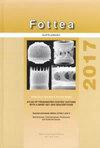青海热带半干旱高原土壤结皮中青藻属二新种(青藻科)
IF 1.4
3区 生物学
Q3 PLANT SCIENCES
引用次数: 13
摘要
采用形态学、生态学、16S rRNA和16S- 23s ITS系统发育、16S rRNA基因序列同源率、16S- 23s ITS序列异同率、ITS保守结构域二级结构等多相分析方法对墨西哥干旱和半干旱热带高地生物土壤结皮中分离的2株Oculatella进行了鉴定。根据我们的分析和该属其他物种的分析,这两个物种在成熟的顶端细胞顶端有一个红色颗粒的一般突触,并且具有一个具有tRNA基因(tRNAIle和tRNAAla)的核糖体操纵子。鉴定后,将该菌株与该属中已有的10个描述和特征相似的种进行比较,根据所获得的证据,将该菌株描述为两个新种:O. dilatativagina和O. leona。O.扩张阴道有一个广泛加宽的鞘,因此在形态学上与迄今为止所描述的所有其他分类群分开。在形态上与在北美和南美发现的土壤物种高度相似,应被认为是这些分类群中的隐种。最近建立的基于ITS基因序列异度百分比的物种识别标准被发现可以有效地分离出Oculatella的隐种,并且对于其他蓝藻属中密切相关的物种的分离一直是有用的和充分的。本文章由计算机程序翻译,如有差异,请以英文原文为准。
Two new Oculatella (Oculatellaceae, Cyanobacteria) species in soil crusts from tropical semi-arid uplands of México
Two isolates of Oculatella from biological soil crusts in the arid and semi-arid tropical upland region of Mexico were characterized using a polyphasic approach which included morphology, ecology, 16S rRNA and 16S-23S ITS phylogenetic analysis, percent identity of 16S rRNA gene sequence, percent dissimilarity of 16S-23S ITS sequence, and secondary structure of conserved ITS domains. The two species shared the generic synapomorphy of a reddish granule at the tip of mature apical cells, and possessed a single ribosomal operon with both tRNA genes (tRNAIle and tRNAAla) based upon our analysis and the analysis of the other species in the genus. After characterization, the strains were compared with 10 previously described and similarly characterized species in the genus, and based upon the evidence obtained, the strains were described as two new species, O. dilatativagina and O. leona. O. dilatativagina has an extensively widened sheath, and thus is morphologically separated from all other taxa described thus far. O. leona is morphologically highly similar to soil species found in North and South America, and should be considered a cryptic species among these taxa. The recently developed criterion for species recognition using percent dissimilarity among ITS gene sequences in orthologous ribosomal operons was found to be effective in separating cryptic species of Oculatella, and has consistently been useful and sufficient for separation of closely related species in other cyanobacterial genera.
求助全文
通过发布文献求助,成功后即可免费获取论文全文。
去求助
来源期刊

Fottea
生物-植物科学
CiteScore
4.00
自引率
9.10%
发文量
20
审稿时长
>12 weeks
期刊介绍:
Fottea is a journal of Czech Phycological Society (formerly bulletin Czech Phycology). Fottea publishes papers on all aspects of the ecology, physiology, biochemistry, cell biology, molecular biology, systematics and uses of algae (including cyanobacteria)
 求助内容:
求助内容: 应助结果提醒方式:
应助结果提醒方式:


